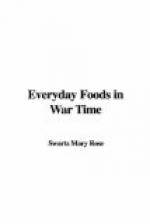Changing our food customs is difficult because it means also changing our cooking customs. But many dishes can be made with less fat than we are accustomed to put in or with different kinds from those we have hitherto preferred. Often the fat from frying is left in the pan to be washed out and thrown away. If every cook could say to herself, “Every two drops of fat make a calorie and every calorie counts in the world today,” it might seem more worth while to hold the pan a minute and drain out the fat for further use. A thousand calories mean a day’s life to a baby. It is always more wholesome to cook foods so that they are not coated with fat, and one may get brown products in a frying pan without more than a thin film of fat to keep the food from sticking. It is well to remember in this connection that the unsalted lard substitutes are more satisfactory than the saltier fat foods, in which there may be a trace of milk.
The thought that fat is fuel wherever we find it in food will stiffen our resolution to take a little pains with the fats which we have been wont to discard. Anyone can get from the Department of Agriculture suggestions for the practical use of chicken, mutton, beef, and other kinds of meat fats. The main points are to free them from flavor, by melting them with milk or water, possibly using some special absorbent like potato or charcoal too, and then mixing hard and soft together, just as the oleomargarine-makers do, to get such a degree of hardness as suits one’s purpose. All this requires time and thought. Let no one dream that the patriotic duties of the kitchen are trivial. Anything that is worth while costs something; money, thought, labor—perhaps all three. To salvage kitchen fat may not be economical in time and labor (though it generally is more so than one might think), but there is more time and labor than food available today. So it seems the “bit” of the housekeeper to set a standard for her family as to the amount of fat she will purchase per week, which is at least one-fourth lower than their ordinary consumption, and to depend upon special conservation of what may have gone to waste hitherto for any increase in this allowance.
CHAPTER VII
“SUGAR AND SPICE AND EVERYTHING NICE”
“Do come and taste how nice the burnt pig eats!” So cried the miscreant son of Hati when his attempt to rescue his father’s live-stock from utter destruction resulted (at least according to Lamb) in adding one more delicacy to the table of civilized man. That the “burnt pig” commended itself instantly to the taste of other men is attested by the recklessness with which they ignited their own houses to secure the new sensation again.
Not all flavors make an immediate appeal. Many persons can mark the time when they learned to like olives, or tomatoes, or tea. The taste for some foods was acquired so early that there is no consciousness of any time when they were not enjoyed, and the impression prevails that the liking for such foods is instinctive. Sometimes that is the case, but quite as often not. Children have to be taught by patient repetition to like most of the common foods which make the staples of the diet, and likings thus acquired are as strong as those which seem more natural.




